|
This is the story of Private Charles H. Nickerson. It is a story of bravery, suffering, survival, and tragic destiny that was shared with hundreds of soldiers during the Civil War. You can see all of the documents that tell the story of Charles Nickerson in our Regimental Files and request copies by sending an email to stri_administration@nps.gov. 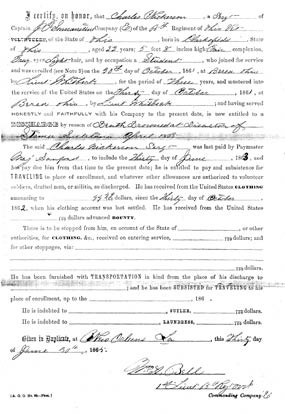
Answering the Call Like thousands of other young men across the United States of America, Charles H. Nickerson answered President Lincoln's 1861 call for 75,000 volunteers to put down the rebellion in the southern states. Charles Nickerson joined Company E of the Sixty-fifth Ohio Infantry when he was 19 years old on October 30, 1861. 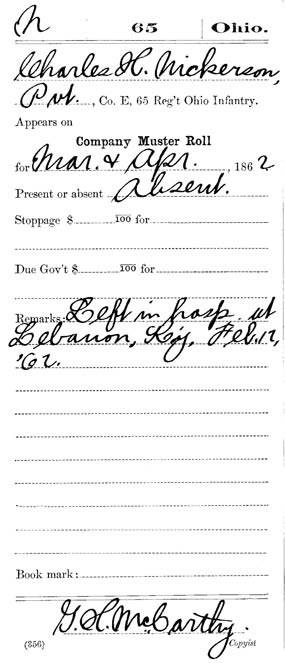
Struck Down By Illness Nickerson missed the battle of Shiloh (April 6-7, 1862) because he had the measles. He returned to his regiment in time to fight the Battle Of Perryville in Kentucky on October 8, 1862. Charles was lucky. Disease caused nearly two thirds of all Civil War deaths. 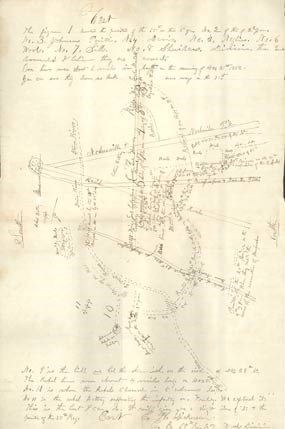
Trials and Triumphs at Stones River On December 26, 1862, the Union Army of the Cumberland, including Nickerson and the Sixty-fifth Ohio, began marching towards Murfreesboro to attack the Confederate Army of Tennessee. Charles mentions several items in his journal that he had at the beginning of the march south including, "1 large blanket and overcoat, haversack with three days rations, [his]gun and accoutrements." The 65th Ohio stopped marching at 9 PM. They didn't have any tents. However, Nickerson had his blanket, a fact that made him proud. During the course of the battle, the Confederates forced the Sixty-fifth Ohio to retreat and reform their lines. While retreating Nickerson threw away the blanket that made him so proud. He also tried to get rid of his haversack and canteen but could not get them off. Shortly after discarding his blanket, Nickerson met his Major who asked him if he was wounded. Nickerson responded, "No, only nearly tired out." The Major looked at Nickerson and told him he is wounded and to get to the rear of the lines across the pike. At this point Nickerson wiped sweat off his face and is stunned to see his hand covered with blood. 
Moving Up in Murfreesboro After the Confederates withdrew from Murfreesboro, General Rosecrans gave orders to fortify the area. The Sixty-fifth Ohio helped build part of Fortress Rosecrans. Private Nickerson wrote that the breastworks they were building were "very strong." The Fortress protected an area of more than 200 acres and a vast supply depot. While in Murfreesboro, Private Nickerson became Sergeant Nickerson. Many promotions occurred during the first half of 1863 as the Union army prepared itself for a drive towards Chattanooga. 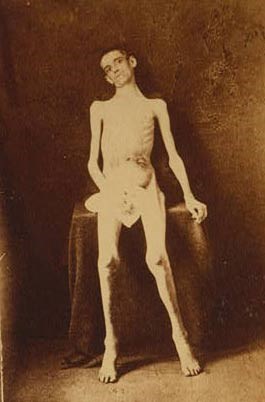
LIBRARY OF CONGRESS Prisoner of War In September the 65th Ohio took part in the Battle of Chickamauga. During this battle Sergeant Nickerson was wounded and captured. He went to a prison camp near Richmond, VA. In the spring of 1864 he transferred to the newly opened camp at Andersonville, Georgia. He spent the rest of the war there. Sergeant Nickerson did not die at Andersonville as many others did. Near the end of the war he and several hundred other Union Prisoners of War moved to Vicksburg, Mississippi to begin their passage home. These men were weakened from their experiences in Andersonville. 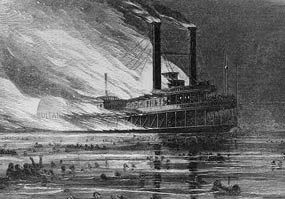
LIBRARY OF CONGRESS Tragedy on the Mississippi In April of 1865 Sergeant Nickerson boarded the S.S. Sultana excited at the prospect of heading home. The Sultana was 260 feet long and had a legal carrying capacity of 376 passengers and crew. One of the Sultana's boilers had a bulging wall plate. Instead of replacing it entirely the Captain decided to have the defect patched. On April 27, 1865 this poorly repaired boiler exploded when the Sultana was 9 miles north of Memphis, TN. The explosion killed more than 1,800 men. Charles Nickerson and hundreds of men who had so recently left the horrors of Andersonville behind were among the dead. Charles Nickerson's death after surviving so many trials is one of many tragic endings that make up the story of the Battle of Stones River and the Civil War. |
Last updated: February 2, 2020
